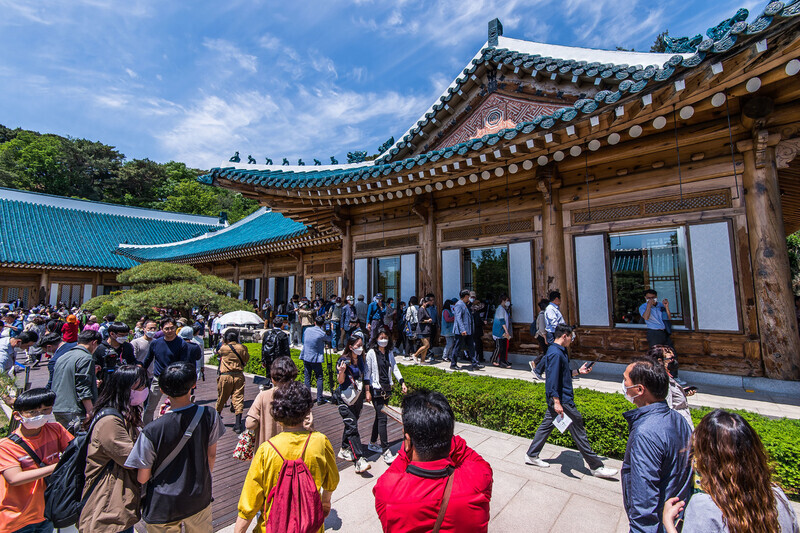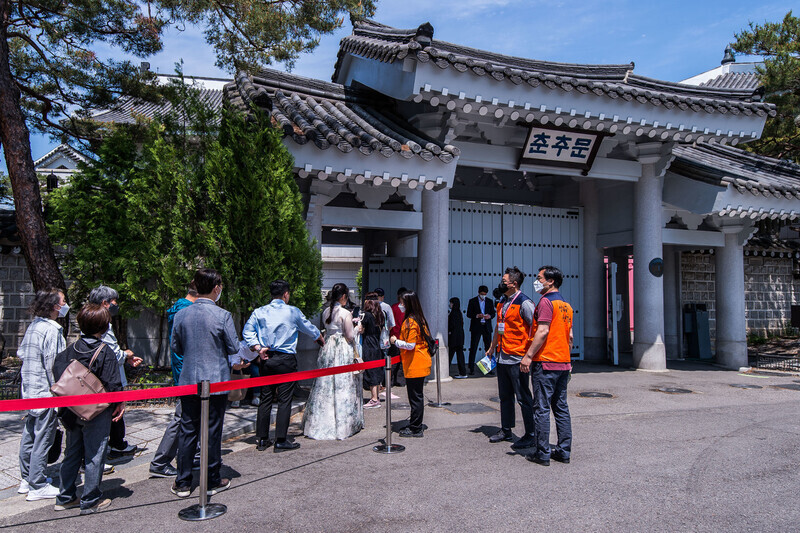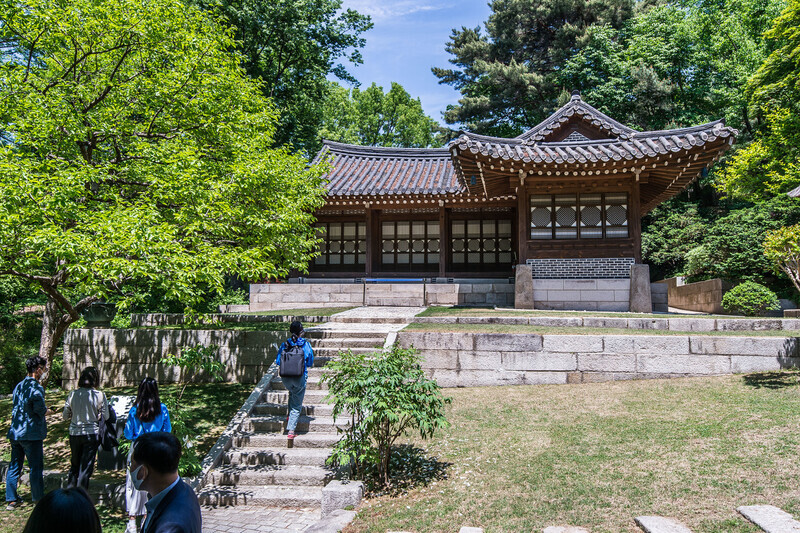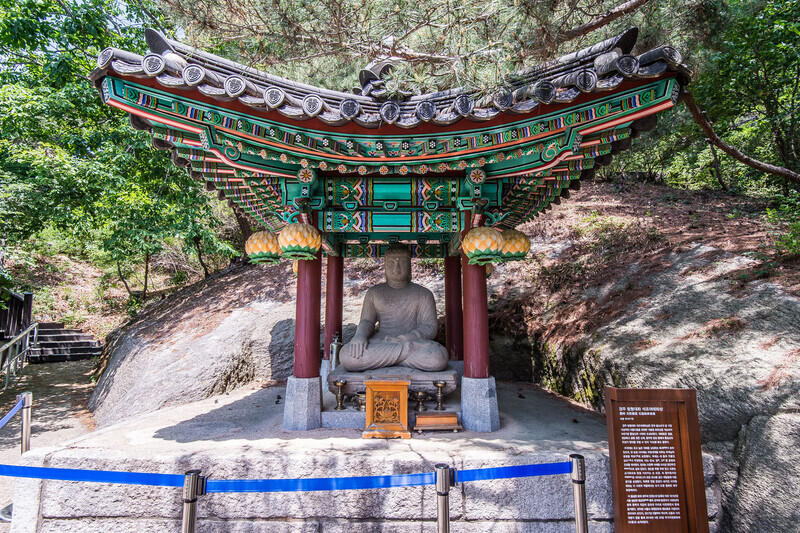hankyoreh
Links to other country sites 다른 나라 사이트 링크
Historic Blue House faces uncertain future after president’s big move out

The cultural preservation community is currently being haunted by the nightmare that was modern Changgyeong Palace, which was downgraded to a park after its storied scenery was brought to ruins during the Japanese colonial period and the rule of dictators.
Debate is stirring surrounding the future of the Blue House area in Seoul, which was where the official rear garden of Gyeongbok Palace, the main palace of the Joseon dynasty, was located, and which has served as the residence of South Korea’s heads of state for the past 83 years.
The public’s interest in the Blue House and its grounds remains high, the number of visitors to the former presidential office and residence totaling more than one million in the two months since they were opened to the public. However, because the current presidential office has yet to announce how the space will be used in the future, cultural heritages and facilities within the Blue House’s grounds have been damaged by inconsiderate visitors.
Plus, the Cultural Heritage Administration (CHA), which is temporarily handling the management of the Blue House, and the Ministry of Culture, Sports and Tourism (MCST), the agency that oversees the CHA, are butting heads due to their disparate views about how the Blue House area should be used.

According to the Hankyoreh’s reporting on the MCST and the CHA, since being designated by the presidential office to temporarily manage the Blue House on May 23, the CHA attempted to simultaneously investigate the major cultural heritages within the Blue House area in order to bring to light its historicity and sense of place while pursuing the Blue House’s designation as a national historic site.
However, the MCST reportedly put the brakes on the CHA’s plans, opposing the Blue House area’s designation as a national historic site by advocating for the idea that it should become a space for recreational cultural facilities such as a gallery, theater, or library for the public.
Furthermore, the MCST is also reportedly preparing a proposal which names a team of bureau chiefs under the MCST as in charge of the overall management of the Blue House area’s administration and reuse, all the while reducing the role of the CHA so that it would only be in charge of deliberating with the MCST regarding pending issues such as the preservation and management of cultural heritages, as well as their designation as natural monuments and registered cultural properties. The MCST reportedly plans to report the proposal in question to President Yoon Suk-yeol on Wednesday.
“The MCST is reportedly extremely opposed to designating [the Blue House area] as a national historic site, as that would immensely limit the use of the [Blue House’s] grounds as well as facilities constructions there,” a CHA official commented.
Regarding this, since Culture, Sports and Tourism Minister Park Bo-gyoon’s inauguration in May, high-ranking officials belonging to the ministry have reportedly consistently contacted CHA bureau chiefs for coordination purposes, demanding the latter to intimately cooperate with the MCST concerning the general administrative authority over the Blue House area. Park especially stressed the need for the CHA’s cooperation, reportedly communicating to the CHA the idea of turning the Blue House into a cultural complex, with the MCST at the helm of such efforts, since beginning his term.
Officials within the CHA refrained from making official comments, stating that “nothing has been confirmed, as discussions are still ongoing.” However, some working-level CHA staff and Cultural Heritage Committee members were vehemently against the MCST for pushing to turn the Blue House area into a recreational space while ignoring its historicity and sense of place — all the while disregarding the CHA, an independent external agency of the MCST.

In fact, a CHA task force for opening the Blue House to the public was originally planning a press release titled “Promoting the Management of and Research into the Blue House for its Sustainable Preservation” for July 4, outlining the CHA’s full-scale push to strengthen the everyday management of items of cultural and natural heritage within the Blue House area, as well as the CHA’s intention to carry out basic research into those cultural and natural heritages and designate them as cultural assets. However, due to Park’s mention of the MCST’s idea to turn the Blue House into a cultural complex during a press conference on the same day, the CHA indefinitely postponed the distribution of the press release.
Park reportedly did not coordinate with the CHA in regard to his comment. The CHA’s spokesperson stated that the organization’s press release was postponed so that the material could be supplemented, but other CHA officials said it was postponed so that the administration could coordinate with the MCST following Park’s comment that contradicted the CHA’s policy regarding the Blue House’s management.
Observers also analyzed that the Cultural Heritage Committee’s field survey of the Blue House took place in mid-June, over a month after the Blue House was opened to the public, due to pressure from the MCST.

Observers in the cultural assets world pointed out that the presidential office, which has actual ownership over the Blue House’s grounds, complicated the debate surrounding the former presidential office and residence by rushing to open the Blue House to the public while keeping silent about the area’s value as a heritage and failing to elaborate on how the area would be preserved for over two months since its opening.
University of Seoul professor Lee Kang-kun, who is a historian of architecture, said, “The Blue House area is a unique space that has barely any precedent in the world, which remained at the center of power for nearly 1,000 years, from the Goryeo dynasty, when it was the royal villa in Namgyeong, and the Joseon dynasty, when it was the rear garden of the main palace, to the 21st century, when it was the presidential office and residence.”
He continued, “A policy focused on opening up the Blue House to the public and turning it into a recreational space that isn’t premised on finding and recovering the space’s historicity will inevitably garner criticism and resistance from both the cultural assets world and the culture field at large.”
By Noh Hyung-seok, staff reporter
Please direct questions or comments to [english@hani.co.kr]

Editorial・opinion
![[Editorial] Intensifying US-China rivalry means Seoul must address uncertainty with Beijing sooner than later [Editorial] Intensifying US-China rivalry means Seoul must address uncertainty with Beijing sooner than later](https://flexible.img.hani.co.kr/flexible/normal/500/300/imgdb/original/2024/0517/8117159322045222.jpg) [Editorial] Intensifying US-China rivalry means Seoul must address uncertainty with Beijing sooner than later
[Editorial] Intensifying US-China rivalry means Seoul must address uncertainty with Beijing sooner than later![[Column] When ‘fairness’ means hate and violence [Column] When ‘fairness’ means hate and violence](https://flexible.img.hani.co.kr/flexible/normal/500/300/imgdb/original/2024/0516/7417158465908824.jpg) [Column] When ‘fairness’ means hate and violence
[Column] When ‘fairness’ means hate and violence- [Editorial] Yoon must stop abusing authority to shield himself from investigation
- [Column] US troop withdrawal from Korea could be the Acheson Line all over
- [Column] How to win back readers who’ve turned to YouTube for news
- [Column] Welcome to the president’s pity party
- [Editorial] Korea must respond firmly to Japan’s attempt to usurp Line
- [Editorial] Transfers of prosecutors investigating Korea’s first lady send chilling message
- [Column] Will Seoul’s ties with Moscow really recover on their own?
- [Column] Samsung’s ‘lost decade’ and Lee Jae-yong’s mismatched chopsticks
Most viewed articles
- 1[Editorial] Transfers of prosecutors investigating Korea’s first lady send chilling message
- 2[Exclusive] Unearthed memo suggests Gwangju Uprising missing may have been cremated
- 3S. Korea “monitoring developments” after report of secret Chinese police station in Seoul
- 4[Editorial] Intensifying US-China rivalry means Seoul must address uncertainty with Beijing sooner t
- 5Could Korea’s Naver lose control of Line to Japan?
- 6[Column] US troop withdrawal from Korea could be the Acheson Line all over
- 7Korea poised to overtake Taiwan as world’s No. 2 chip producer by 2032
- 8Korea cedes No. 1 spot in overall shipbuilding competitiveness to China
- 9Xi, Putin ‘oppose acts of military intimidation’ against N. Korea by US in joint statement
- 10Korea’s first openly trans athlete hopes to prompt a discussion by competing as herself